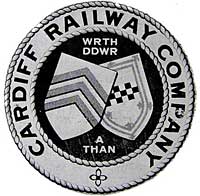Cardiff Railway and the Coryton Branch Line, Cardiff, south Wales
Feature by urban75 editor, October 2005
Line history
The Cardiff Railway was the brainchild of the rich and powerful Marquis of Bute who wanted to break the Taff Vale Railway's (TVR) near total monopoly on coal transportation from the Rhondda valley mines.
The minted Marquis owned Cardiff Docks along with several mines in the Rhondda valley and clearly wasn't too keen on the TVR grabbing a slice of his profits.
 In an attempt to set up his own line for transporting coal, the Marquis purchased the Glamorganshire and Aberdare Canal in 1885 with the aim of closing both and converting them to railways.
In an attempt to set up his own line for transporting coal, the Marquis purchased the Glamorganshire and Aberdare Canal in 1885 with the aim of closing both and converting them to railways.
An act was then passed in 1897 forming the Cardiff Railway Company, giving the company powers to construct a railway using the Rhymney Railway to Heath Junction and joining the Taff Vale south of Pontypridd.
Construction started in 1898, with the first three and a half miles being built from Heath (north Cardiff) to Tongwynlais.
The line then extended past Tongwynlais and on to Treforest, joining the Taff Vale Railway's line to a point just south of Treforest station after traversing a 450-ft skew bridge over the river Taff.

Skew bridge over the river Taff by Treforest station
Meanwhile, the Taff Vale was getting ready to outmanoeuvre their rival by buying a vital strip of land running along the east side of their railway south of Pontypridd, claiming it was for the provision of sidings.
This sparked a lengthy legal dispute between the two companies, with the Taff Vale refusing to give the Cardiff Railway access to their newly purchased land.
The blocking strategy proved effective, ensuring that the first train to connect the two lines on 15th May 1909 was also the last.

Passenger services
With all hope of running a through freight service crushed and Taff Vale main line connection remaining off-limits, a reduced passenger service as far as Rhydfelin started up in 1911, but slim profits ensured that the service was cut back to Coryton twenty years later in July 1931 - ten years after the Cardiff Railway was absorbed into the Great Western Railway.
This left just five stations open on the line; Heath Low Level, Birchgrove, Rhiwbina, Whitchurch and Coryton. A sixth station, Ty Glas, was opened between Heath and Birchgrove in the 1990s.

A Nantgarw-bound train passes through a weed-strewn Tongynlais station in 1950
The return of freight
The development of the Nantgarw Colliery in 1938 breathed life back into the line, with a section of the track being reopened as a freight only link.
This was only to last until 1952 when a new link to the colliery was built from just north of Taffs Well station on the Pontypridd-Cardiff branch, with the Coryton-Nantgarw section closing for good in 1953.
There was also a goods line running into the Royal Ordnance Factory by Birchgrove during the war, and some tracks were still in place - albeit almost lost under heavy undergrowth - in the mid 1970s.

The future
After line surviving a succession of closure proposals throughout the 60s and 70s, ambitious plans were hatched to link the line up to Radyr to form a suburban inner circular route.
Unfortunately, the scheme has yet to get past the drawing board, although the plan still occasionally resurfaces.
3. Question – What proposals are there within the Local Transport Plan for the Radyr - Coryton loop?
Response – The Radyr - Coryton loop is not included in current SWIFT schemes. There is an issue of line capacity. There is an opportunity to extend the Coryton branch to Radyr and expand the line to two tracks, creating either a circular route, or a route feeding into northbound services to Taffs Well, and serving Morganstown.
A 'park and ride' facility could be built near the M4, and other possibilities, e.g. a shuttle bus service between Llandaff-UHW-Heath, could be provided if funding is available for the infrastructure and to subsidise the trains.
 Joint Environmental and Scrutiny Committees (Dec 2000) Joint Environmental and Scrutiny Committees (Dec 2000)
With or without the extension, the future of the Coryton branch currently seems fairly secure, with the line enjoying regular trains into Cardiff and Barry Island.
|

